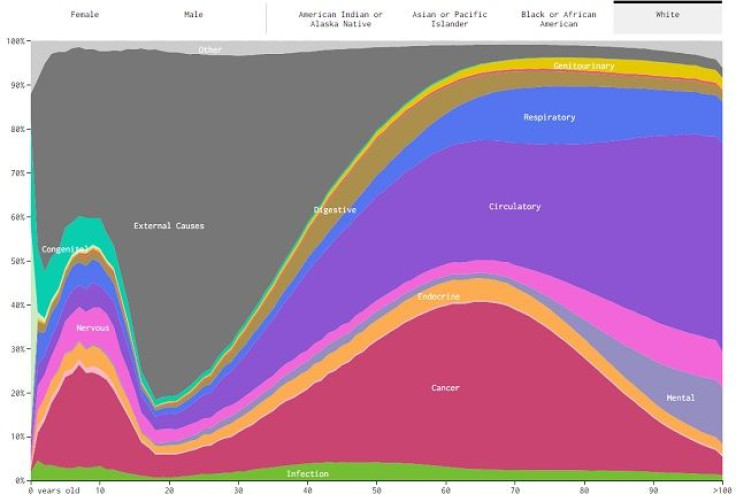An Interactive Guide Lays Out How We'll Die, Depending On Our Age, Gender, And Race

It’s a pithy biblical oldie straight from the Book of Matthew: “Watch therefore, for you know neither the day nor the hour.”
While Matthew’s writer was referring to the prophesied return of Jesus Christ, it’s a saying that could easily apply to death itself. But though the circumstances behind our eventual demise are a mystery that only gets solved after the fact, UCLA statistician Nathan Yau’s interactive guide, a screenshot of which can be seen above, may help us narrow it down.
Released this January on his website Flowing Data and most recently featured on Vox, Yau’s dazzling death display is based on the most recent 10 years of mortality data in the Center for Disease Control and Prevention’s WONDER database, which classifies 122 causes of death into 20 broad categories.
Considering our average life expectancy now hovers around the age of 75, the graphic clearly isn’t meant to be a representation of absolute death rates across our lifespans. Instead, it tells us that if we were, for instance, a white female who died at the age of 20, the chance that cancer would be the cause falls somewhere below 10 percent; if we died at age 60, that number would rise to 40 percent.
And there are some interesting differences between groups. Though accidents and other “external causes” are the single most likely cause of death until we reach our mid 40s, men are twice as likely to die of them than women throughout their lives — 10 percent overall compared to 5 percent. For American Indians and Alaska Natives, that figure jumps up to 17 percent, though they are less likely than any other race to die of cancer.
If the toggling visualization isn’t enough of a morbid curiosity for you, Yau has an accompanying interactive chart that not only allows you to see your most likely causes of death at various ages, but what proportion of people of your race and gender are likely to still be alive at that age.
In the case of yours truly, an enterprising Hispanic white 27-year-old reporter, 2 percent of people like me have already passed onto greener pastures. And it would take until my 60s before that figure would eclipse 25 percent. Good odds for a long-lived life in other words. But then you never really do know, do you?



























